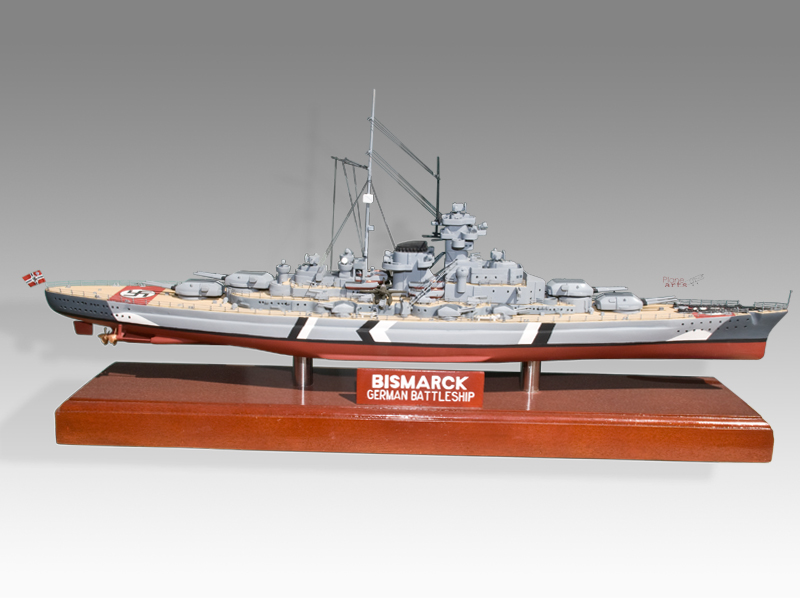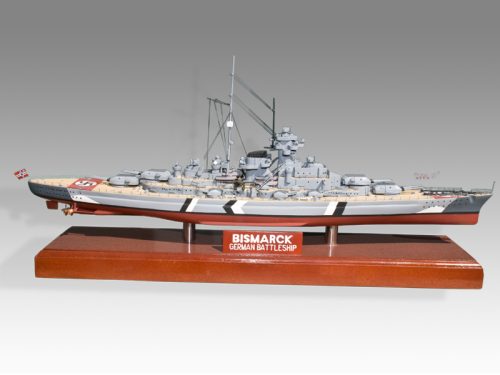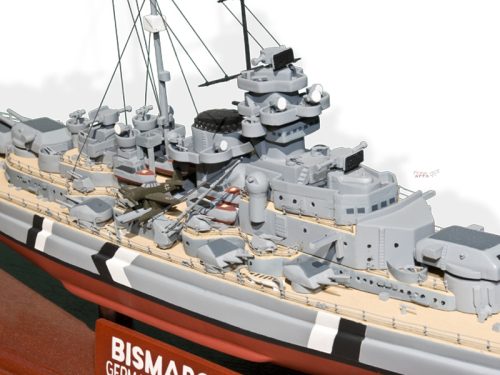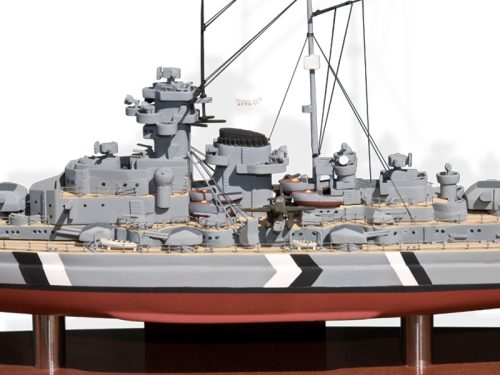Bismarck
Production Time 9 to 10 weeks
Shipment is by FedEx, UPS or DHL International Express Courier with a normal door-to-door delivery time worldwide of within 2-3 business days after dispatch. Due to the current volatility of world fuel prices, the amount mentioned here is our best estimate for DHL and UPS and may be subject to change at the time of shipping.

Model Description: Bismarck Wood Replica Scale Custom Model
Manufacturer: Blohm & Voss, Hamburg
$1,150.00
Production Time 9 to 10 weeks
-
United States dollar ($)
-
Pound sterling (£)
-
Euro (€)
-
Australian dollar ($)
-
Canadian dollar ($)
-
Singapore dollar ($)
-
Swiss franc (CHF)
-
Japanese yen (¥)
-
Danish krone (kr.)
-
Hong Kong dollar ($)
-
Norwegian krone (kr)
-
Swedish krona (kr)
-
United Arab Emirates dirham (د.إ)
General Product Description
Our PlaneArts Bismarck replica exhibits unique, unrivaled quality and detailed design to come as close as possible to the accuracy of the actual craft. It comes as standard with a robust, durable base or stand which is available in a variety of different finishes designed to match your own personal requirements including solid wood, wood with polished metal supports or adjustable wood wall mount and will be ready within about 8-10 weeks from placement of order.
The Bismarck model is made of the finest kiln dried renewable mahogany wood (commonly known as Lauan or Meranti) which has undergone many stages of carving and meticulous and careful sanding giving the beautiful, finished museum quality masterpiece. Many collectors and model connoisseurs demonstrate their preference for genuine handmade and hand painted mahogany wood models rather than plastic or die cast (diecast) alternatives due to the overall look and totally different feel of the item - we trust you will find the same. We can however, if required produce the same model in Solid Cast Resin so just click and contact us for further information. Our craftsmen and gifted artisans ensure that our finely handcrafted model watercraft match the precise blueprint details of the original version. The paint scheme, markings and parts are closely matched, reflecting the original. This stylish top-quality desktop replica model will surely enthrall anyone who receives this as a gift and for sure one of the most appropriate and desirably collectable gifts for any boat, ship or similar enthusiast and avid collector whilst also displaying a perfect resemblance to the actual craft itself.
If you require, we can also make this model in any other private livery, markings or colour scheme you require and if necessary, in a different size or scale. Just click here to contact us with a description or photographs of what you require and we will let you have a quotation for the necessary customization by return email. We can also make bespoke scale replicas of any other private / civil commercial airliner or airliners, helicopter, glider, gliders with engines, military jet, warplane jets, propeller warplanes, biplane, triplane, tail fin, spacecraft, rocket or NASA model you require in any airline, military or civilian livery or colors. We also produce boat and ship collectibles. Wall plaque or seal for military, government or private customers. Again, by clicking here to contact us just let us know exactly what you need.
The Mighty Bismarck: A Behemoth of Naval Warfare
The Bismarck, one of history’s most formidable battleships, continues to captivate the imagination of naval enthusiasts and historians alike. Launched by Nazi Germany in 1939, it was the lead ship of its class, which included its sister ship, the Tirpitz. The Bismarck’s design, armament, and brief yet impactful wartime service underline its iconic status in naval warfare history. This article delves into the essential features and historical significance of the Bismarck, shedding light on why it remains a subject of enduring fascination.
Design and Specifications: A Marvel of Engineering
The Bismarck was a testament to early 20th-century engineering and military might, designed to outmatch any naval power it encountered. Measuring over 250 meters in length and displacing more than 50,000 tons when fully loaded, its size alone was a clear statement of German naval ambition. The battleship was powered by three steam turbines and twelve boilers, enabling it to reach speeds up to 30 knots (about 55 km/h), making it one of the fastest battleships of its time.
Armor protection was a paramount feature, with belt armor reaching up to 320 mm thick and a main deck up to 120 mm thick, designed to withstand considerable punishment. Such heavy armor aimed to ensure the Bismarck’s survivability in the face of enemy fire, enabling it to engage Allied naval forces with confidence.
Armament: A Floating Fortress
The Bismarck’s primary armament consisted of eight 15-inch (380 mm) guns housed in four twin turrets, capable of delivering devastating salvos at ranges exceeding 30 kilometers. This firepower was complemented by a battery of secondary armament designed for anti-ship and anti-aircraft defense, including twelve 5.9-inch (150 mm) guns, sixteen 4.1-inch (105 mm) guns, and various smaller calibers for close-range defense. The battleship also carried four aircraft for reconnaissance and spotting the fall of its shells, further enhancing its operational capabilities.
Operational History: A Short-Lived Titan:
The Bismarck’s operational history was brief yet dramatic. Its maiden voyage in May 1941 marked the beginning and end of its active deployment. Tasked with disrupting British Atlantic convoys, the Bismarck, accompanied by the heavy cruiser Prinz Eugen, encountered British naval forces in the Denmark Strait. In the ensuing Battle of the Denmark Strait, the Bismarck’s formidable guns sank HMS Hood, the pride of the Royal Navy, with a direct hit to the magazine, killing all but three of the 1,418 crew members aboard the Hood.
However, this victory was short-lived. Damaged in the battle and pursued by an unrelenting British naval force, the Bismarck was eventually cornered and sunk on May 27, 1941, after a relentless assault involving surface ships and aircraft. Of its crew of over 2,000 men, only about 114 survived, marking a tragic end to the Bismarck’s brief but storied career.
Legacy: A Symbol of Naval Power and Tragedy:
The sinking of the Bismarck had significant military and symbolic repercussions. It highlighted the strategic importance of naval air power and marked a turning point in how naval engagements would be conducted in the future. For Nazi Germany, it was a devastating blow to naval prestige and ambitions. For the Allies, it was a hard-fought victory that demonstrated their resolve and capability to counter Axis naval threats.
Today, the Bismarck remains an enduring symbol of naval might and technological prowess, as well as a poignant reminder of the human cost of war. Its story continues to be studied and remembered, a testament to its impact on World War II and naval warfare history.
| Weight | 6 kg |
|---|---|
| Dimensions | 28 in |











Reviews
There are no reviews yet.